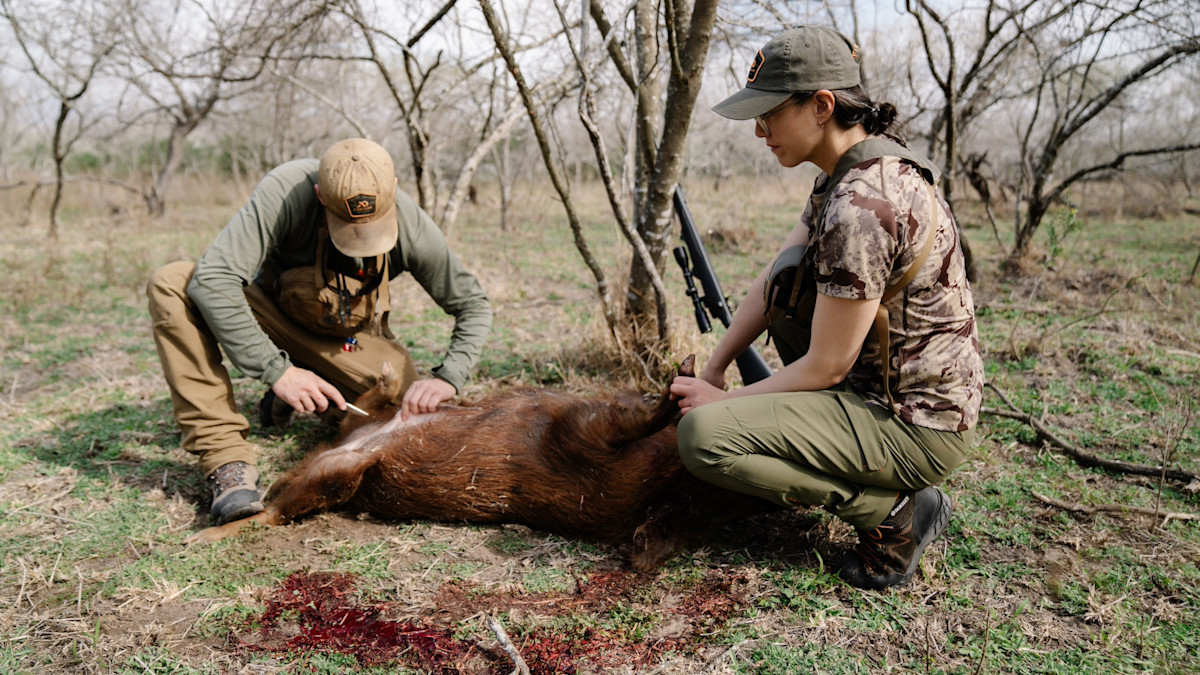
Mammals differ from species to species, but inside the chest, they are remarkably similar. Here, we’ll take a detailed look at the anatomy of feral hogs to better understand where shots will have the most impact. The following dissection of a hog demonstrates proper shot placement for that species, but it can offer sportsmen guidelines for precise target selection on other game animals as well. Two things worth bearing in mind are the position of the heart and the level of the spine in the forward section of the chest.

Of great importance is the drop of the spine from the back to the front of the chest. The yellow lines mark the top of the back and the bottom of the chest, and in the region of the shoulder, the spine is about halfway between them.
First, it should be pointed out that the bones of the leg angle forward at a level corresponding to the bottom of the chest so they don’t block access to the heart. Another consideration is the hunter’s choice of weapon. A bullet or arrow through the heart will cause a quick death, but adrenaline release can spur the animal to cover an immense distance in the remaining few seconds of life. Therefore, some rifle hunters prefer to shoot for the shoulder blade and spine to anchor the animal on the spot. This is not recommended for bow hunters.
The lungs fill most of the chest cavity back to the diaphragm. Shots that pierce both lungs are also quickly fatal. Keep in mind that the diaphragm curves forward into the chest from its attachment with the ribcage, and the paunch extends into the region. The lungs become very thin where the diaphragm meets the ribs. For bow hunters, heart or lung shots are ideal.
As the photographs show, the heart is located about one-third of the distance from the bottom to the top of the chest, directly above the back edge of the leg if the animal is exactly broadside. On a quartering animal, the hunter must judge a spot midway between the backs of the two legs; slightly behind the back edge of the nearest for quartering away and in front for quartering toward. Quartering toward shots can be problematic for bowhunters because now the denser bones come into play, and it makes sense to avoid them.

Shots impacting above the spine are unlikely to bring about a recovered animal. The heart is the most reliable target. However, a rifle hunter may wish to hit the front location marked "spine" to anchor the animal on the spot.
The spine is near the top of the back in the abdomen and in the rearmost region of the chest. Looking at an animal, the back appears to progress forward toward the head in a straight line. However, this illusion is accomplished by longer and longer fins sticking up from the individual vertebrae in the forward part of the chest.
Meanwhile, the spine itself drops low in the chest, usually about halfway down from the top of the back to the bottom of the chest. Above and in front of the shoulder, impact above the spine will not cause a fatal wound unless the shock of the blow to a vertebral fin concusses the spinal column or, much later, infection results. Many reported chest wounds that do not result in a recovered animal are likely cases where the chest itself was never breached because of the low position of the spine.
A lot of choice in picking the precise aimpoint depends on the hunter’s ability, the weapon, the steadiness of the rest, whether the game is stationary or moving, and the distance to the animal. It is always best to choose targets you have the utmost confidence in hitting. If conditions diminish the probability of a perfect shot, lethal areas of bigger proportions can be considered. For instance, the heart/lung shot offers more room for error than a spine shot.
Fluent awareness of chest anatomy can help both bow and gun hunters consistently deliver quick, lethal shots. One of my books, Tales of Trails – Finding the Game After the Shot (2nd edition), offers detailed information and practical knowledge all hunters can find useful.
Want to learn more about hunting and cooking wild hogs? Check out these articles: 5 Best Hog Hunting Calibers, 3 Easy Ways to Make Any Wild Hog Delicious, and Cuban-Inspired Hog Leg with Mojo Sauce.






